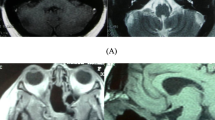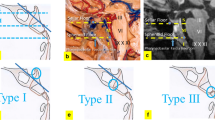Abstract
Chordomas are rare and slow-growing locally destructive bone tumors that can develop in the craniospinal axis. It is commonly found in the sacrococcygeal region whereas only 25–35% are found in the clival region. Headache with neurological deficits are the most common clinical presentations. Complete surgical resection either via open or endoscopic endonasal approaches are the main mode of treatment. Here, we report a series of 5 cases of clival chordomas which was managed via endoscopic endonasal approaches in our center. A retrospective analysis of patients who had undergone endoscopic endonasal resection of clival chordoma in Sarawak General Hospital from 2014 to 2018. A total of 5 cases were operated on endoscopically via a combine effort of both the otorhinolaryngology team and the neurosurgical team during the study period from year 2013 to 2018. From our patient, 2 were female and 3 were male patients. The main clinical presentation was headache, squinting of eye and nasopharyngeal fullness. All our patient had endoscopic endonasal debulking of clival tumor done, with average of hospital stay from 9 – 23 days. Pos-operatively, patients were discharged back well. Endoscopic endonasal resection of clival chordomas gives good surgical resection results with low morbidity rates and therefore can be considered as a surgical option in centers where the surgical specialties are available.




Similar content being viewed by others
References
Khawaja AM, Venkatraman A, Mirza M (2017) Clival chordoma: case report and review of recent developments in surgical and adjuvant treatments. Pol J Radiol 82:670–675. https://doi.org/10.12659/PJR.902008
Youssef C, Aoun SG, Moreno JR, Bagley CA (2016) Recent advances in understanding and managing chordomas. Res 5:2902. https://doi.org/10.12688/f1000research.9499.1
Fontes R, O’Toole JE (2012) Chordoma of the thoracic spine in an 89-year-old. Eur Spine J 21(Suppl 4):S428–S32. https://doi.org/10.1007/s00586-011-1980-6
Sun X, Hornicek F, Schwab JH (2015) Chordoma: an update on the pathophysiology and molecular mechanisms. Curr Rev Musculoskelet Med 8(4):344–352. https://doi.org/10.1007/s12178-015-9311-x
Catala M (2003) Embryology of the sphenoid bone. J Neuroradiol 30:196–200
Kim KH (2014) Intradural clival chordoma: a case report. Brain Tumor Res Treat 2(2):76–80. https://doi.org/10.14791/btrt.2014.2.2.76
Walcott BPNB, Mohyeldin A, Coumans JV, Kahle KT, Ferreira MJ (2012) Chordoma: current concepts, management, and future directions. LANCET Oncol 13(2):69–76
Yousaf J, Afshari FT, Ahmed SK, Chavda SV, Sanghera P, Paluzzi A (2019) Endoscopic endonasal surgery for clival chordomas—a single institution experience and short term outcomes. Br J Neurosurg. https://doi.org/10.1080/02688697.2019.1567683
Sahyouni R, Goshtasbi K, Mahmoodi A, Chen JW (2018) A historical recount of chordoma. J Neurosurg Spine 28(4):422–428. https://doi.org/10.3171/2017.7.spine17668
Campbell RG, Prevedello DM, Ditzel Filho L, Otto BA, Carrau RL (2015) Contemporary management of clival chordomas. Curr Opin Otolaryngol Head Neck Surg 23(2):153–161. https://doi.org/10.1097/moo.0000000000000140
Alshammari J, Monnier P, Daniel RT, Sandu K (2012) Clival chordoma with an atypical presentation: a case report. J Med Case Rep 6(1):410. https://doi.org/10.1186/1752-1947-6-410
Jho HD (2001) The expanding role of endoscopy in skull-base surgery. Indic Instrum Clin Neurosurg 48:287–305
Krespi YP, Har-El G (1988) Surgery of the clivus and anterior cervical spine. Arch Otolaryngol Head Neck Surg 114(1):73–78. https://doi.org/10.1001/archotol.1988.01860130077019
Rai R, Iwanaga J, Shokouhi G, Loukas M, Mortazavi M, Oskouian R et al (2018) A comprehensive review of the clivus: anatomy, embryology, variants, pathology, and surgical approaches. Child’s Nervous Syst 34:1451–1458
Wang S-S, Li J-F, Zhang S-M, Jing J-J, Xue L (2014) A virtual reality model of the clivus and surgical simulation via transoral or transnasal route. Int J Clin Exp Med 7(10):3270–3279
Garzaro M, Zenga F, Raimondo L, Pacca P, Pennacchietti V, Riva G et al (2016) Three-dimensional endoscopy in transnasal transsphenoidal approach to clival chordomas. Head Neck 38(Suppl 1):E1814–E1819. https://doi.org/10.1002/hed.24324
Garzaro M, Pecorari G, Riva G, Pennacchietti V, Pacca P, Raimondo L et al (2019) Nasal functions in three-dimensional endoscopic skull base surgery. Ann Otol Rhinol Laryngol 128:208–214
Paluzzi A, Gardner P, Fernandez-Miranda JC, Snyderman C (2012) The expanding role of endoscopic skull base surgery. Br J Neurosurg 26(5):649–661. https://doi.org/10.3109/02688697.2012.673649
Samii A, Gerganov V, Herold C, Hayashi N, Naka T, Javad Mirzayan M et al (2007) Chordomas of the skull base: surgical management and outcome. J Neurosurg 107:319–324
Funding
There is no funding declared in this case series.
Author information
Authors and Affiliations
Contributions
DR. CHIEN YING VINCENT NGU main author (data collection, writing this paper) DR. ING PING TANG co-author (neurosurgeon, designed of surgery, Writing manuscript). DR. BOON HAN KEVIN NG co-author (data review, writing this paper). DR. ALBERT SII HIENG WONG co-author (neurosurgeon, designed of surgery). DR. DONALD NGIAN SAN LIEW co-author (neurosurgeon, designed of surgery.
Corresponding author
Ethics declarations
Conflict of interest
The authors declare that they have no competing interests.
Ethics approval
The authors declare that they have no competing interests.
Additional information
Publisher's Note
Springer Nature remains neutral with regard to jurisdictional claims in published maps and institutional affiliations.
Rights and permissions
About this article
Cite this article
Ngu, C.Y.V., Tang, I.P., Ng, B.H.K. et al. Endoscopic Endonasal Approach in Clival Chordoma Surgery: Case Series. Indian J Otolaryngol Head Neck Surg 73, 226–232 (2021). https://doi.org/10.1007/s12070-021-02455-6
Received:
Accepted:
Published:
Issue Date:
DOI: https://doi.org/10.1007/s12070-021-02455-6




